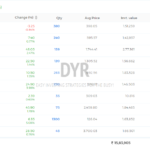It’s been a tumultuous week!
Markets started on the weak footing and fell up to 11185 levels and bounced back by the end of the week to 11464.45. Nifty ended up 1.15% for the week while NIFTY 500 ended up 0.73%.
Yesterday SEBI announced a modification in the structure of the Multi-Cap schemes portfolio allocation. The SEBI increased the allocation in equities from 65% to 75% and further mandated that 25% of the scheme funds be invested in Large Cap, Mid-cap, and Small-cap stocks each.
Many preliminary calculations show that some Rs. 35000 crores will move out from Large Caps or top 100 companies by market cap to mid-cap and small-cap stocks. Small-caps stocks are likely the biggest beneficiary of this change and some 19000 crores will go into them.
Many people are anticipating a huge run up in small-cap & mid-cap stocks!
But it’s too early to cheer in my opinion!
Why?
Well, there are a couple of issues with the new multi-cap portfolio structure as I see it…
- What about the scheme risk? Increasing exposure to small-caps will surely increase the risk of the scheme. In the times of huge redemptions like in the months of July & August, fund managers will find it difficult to sell their small-cap portion and will be required to sell large and mid-cap stocks which will in turn dampen the returns of the scheme and increase risk.
- What if the scheme is reclassified as Flexi-cap or large-cap? The above is likely to dampen the fund manager’s flexibility to invest according to the market scenario.
- What if this ruling defeats the purpose? What I mean is what if investors migrate to large-cap or other schemes where the risk is relatively lesser than multi-cap schemes?
- Also, the actual fund rotation will happen sometime in Feb 2020 I have understood from the circular. AMFI will update the list of stocks according to the past 6 month’s average market capitalization on 31/01/2021. So, those fund managers who have opted to continue with the ruling will probably have to shuffle the portfolio one month from the publication of the new list.
Anyways, we’ll leave the debate whether the step taken by SEBI is good or bad to experts!
But this is a good place to analyze our Dual Momentum Strategy stocks for their market cap rankings!

As you can see that the DYR Dyal Momentum portfolio is well balanced among various market cap stocks. If there is a run-up in small-caps and mid-caps as anticipated, the portfolio will also benefit.
Here’s how the strategies have performed up to the week ended on 11/09/2020.

The highlight here is the DYR Mean Reversion – Long strategy has really picked up as the market has entered into a corrective or sideways pattern. It will continue to do well as long as markets consolidate for some time.
Below is the real-time portfolio performance since 30/06/2020. I apply the combination of mildly correlated strategies which I fondly call as the Hybrid Approach.

The rotational version of the DYR Dual Momentum Strategy combined with DYR Mean Reversion Long & Short strategies has generated 16.3% returns since 30/06/20.
Let’s see how the Hybrid Approach holds up going forward!
Have a great week ahead!







